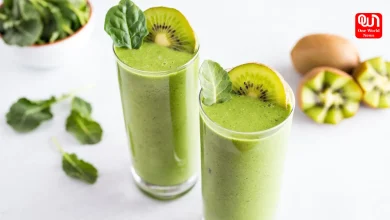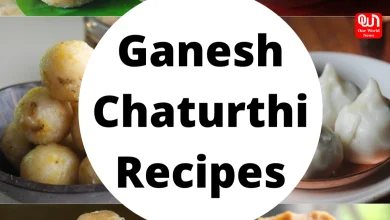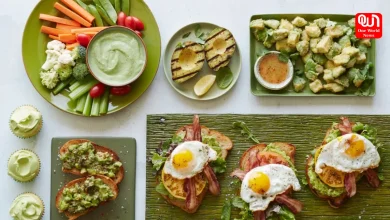3 Indian Festive Recipes to Delight Your Senses and Warm Your Heart
Discover the essence of Indian celebrations through these mouthwatering festive recipes.
Explore the magic of Indian festive recipes – a symphony of flavours and traditions.
Indian festivals are a grand celebration of culture, traditions, and, of course, food. The heart and soul of these festivities lie in the sumptuous dishes that grace the dining tables. Let’s delve into the world of Indian festive recipes, where flavours come alive and traditions are passed down through generations.
Biryani – The Royal Feast:
Biryani, often referred to as the “King of Indian dishes,” is a culinary masterpiece that symbolizes richness and grandeur. This aromatic one-pot dish is a marriage of fragrant basmati rice, succulent meat (or vegetables), and a blend of aromatic spices. To make biryani, marinate the meat in a mixture of yoghurt and spices, sauté it with onions, layer it with partially cooked rice, and slow-cook until perfection. The result is a heavenly dish that offers an explosion of flavours with every bite.
Ingredients:
For the Rice:
2 cups of Basmati rice
4 cups of water
1 bay leaf
2-3 green cardamom pods
2-3 cloves
Salt to taste
For the Vegetable Marination:
2 cups of mixed vegetables (e.g., carrots, peas, beans, potatoes, etc.)
1 cup of thick yogurt
1 teaspoon ginger-garlic paste
1/2 teaspoon turmeric powder
1 teaspoon red chilli powder (adjust to your spice preference)
1 teaspoon garam masala
Salt to taste
For Layering:
2 large onions, thinly sliced
2-3 green chillies, slit
A handful of fresh mint leaves
A handful of fresh coriander leaves
1/4 cup ghee (clarified butter) or vegetable oil
Saffron strands soaked in 2 tablespoons of warm milk (optional)
Fried onions (optional, for garnish)
read more Comfort Evening Food Classics: Timeless Recipes for Cozy Evenings
Whole Spices:
2-3 green cardamom pods
2-3 cloves
1-inch cinnamon stick
1 bay leaf
Instructions:
- Wash the Basmati rice until the water runs clear. Soak the rice in water for about 30 minutes. Drain and set aside.
- In a large bowl, mix the yoghurt, ginger-garlic paste, turmeric powder, red chilli powder, garam masala, and salt. Add the mixed vegetables to the marinade and let them sit for at least 30 minutes.
- In a large pot, bring 4 cups of water to a boil. Add the drained rice, bay leaf, green cardamom, cloves, and a pinch of salt. Cook the rice until it’s 70-80% cooked (it should still have a slight bite). Drain the rice and set it aside.
- In a heavy-bottomed pan, heat the ghee or vegetable oil. Add the whole spices (green cardamom, cloves, cinnamon, and bay leaf) and sauté for a minute until they release their aroma.
- Add the thinly sliced onions and sauté until they turn golden brown. Remove half of the fried onions for garnishing and set them aside.
- Add the marinated vegetable mixture to the pan and cook for 5-7 minutes until the vegetables are partially cooked. Stir occasionally.
- Start layering the biryani. In a large heavy-bottomed pot or a deep ovenproof dish, spread a layer of the partially cooked rice at the bottom. Top it with a layer of the cooked vegetable mixture.
- Sprinkle some fresh mint and coriander leaves, green chillies, and saffron milk on top.
- Continue layering rice and vegetable mixture until you’ve used up all the rice and vegetables.
- Cover the pot with a tight-fitting lid or aluminium foil. Cook on low heat for 20-25 minutes, allowing the biryani to steam. You can also place a heavy pan or tava (griddle) underneath to prevent direct contact with the flame.
- Once done, garnish the biryani with the reserved fried onions and serve hot with raita or a side salad.
Enjoy this flavorful and aromatic Vegetable Biryani, fit for a royal feast!
Gulab Jamun – The Sweet Embrace
No Indian festivity is complete without a sweet touch, and Gulab Jamun fits the bill perfectly. These delectable dumplings are made from khoya (milk solids) and flavoured with cardamom. After frying to golden perfection, they are gently soaked in fragrant sugar syrup infused with rosewater and saffron. The result is a sweet, syrupy delight that symbolizes the essence of togetherness and joy.
Ingredients: For the Gulab Jamun:
1 cup of khoya (milk solids)
2-3 tablespoons of all-purpose flour
1/4 teaspoon baking soda
A pinch of cardamom powder
A few saffron strands (optional)
Ghee or oil for frying
For the Sugar Syrup:
2 cups of granulated sugar
1 cup of water
1/2 teaspoon cardamom powder
A few saffron strands
1-2 teaspoons rose water
Instructions:
For the Sugar Syrup:
- In a large saucepan, combine the sugar and water. Heat over medium heat and stir until the sugar dissolves.
- Add cardamom powder and saffron strands to the sugar syrup. Allow it to come to a gentle boil.
- Simmer the syrup for about 5-7 minutes until it slightly thickens. It should have a one-string consistency, which means that when you take a drop of syrup between your fingers and gently stretch them apart, it should form a single thread. Be careful not to over-thicken the syrup. Once it reaches the desired consistency, remove it from the heat and add rose water. Keep the syrup warm.
For the Gulab Jamun:
- Grate the khoya and place it in a mixing bowl. If your khoya is too dry, you can add a couple of tablespoons of milk to make it soft.
- Add the all-purpose flour, baking soda, and a pinch of cardamom powder to the grated khoya. If you like, you can also add a few saffron strands to the dough for added flavour.
- Mix and knead the ingredients together to form a smooth, soft dough. Be careful not to over-knead, as that can make the Gulab Jamuns tough.
- Divide the dough into small, equal-sized portions and roll them into smooth, crack-free balls. Make sure there are no cracks on the surface of the balls, as this can cause them to break while frying.
- Heat ghee or oil in a deep-frying pan over medium-low heat. To test the oil’s readiness, drop a small piece of dough into the oil. If it rises to the surface gradually and sizzles, the oil is ready.
- Gently slide the Gulab Jamun balls into the hot oil. Be cautious not to overcrowd the pan, as they need space to expand.
- Fry the Gulab Jamuns on low to medium heat, stirring them gently to ensure even browning. They should turn a deep golden-brown colour. This will take about 8-10 minutes.
- Remove the fried Gulab Jamuns with a slotted spoon and drain excess oil on paper towels.
- Immediately place the hot Gulab Jamuns into the warm sugar syrup. Ensure that the syrup covers them entirely.
- Allow the Gulab Jamuns to soak in the syrup for at least 2-3 hours or overnight for best results. They will absorb the syrup and become soft, spongy, and delicious.
Serve your homemade Gulab Jamun as a sweet treat during festive occasions or special gatherings. They are sure to be a hit!
Paneer Tikka – A Vegetarian Delight
For the vegetarian palate, Paneer Tikka is a crowd-pleaser. This dish features marinated cubes of paneer (Indian cottage cheese) and colourful bell peppers, skewered and grilled to perfection. The marination, a blend of yoghurt and aromatic spices, imparts a burst of Flavors and a delightful smokiness. Paneer Tikka is not only a healthy option but also a feast for the senses.
Ingredients:
For the Marinade:
250 grams paneer (Indian cottage cheese), cut into cubes
1/2 cup thick yoghurt
1 tablespoon ginger-garlic paste
1/2 teaspoon red chilli powder
1/2 teaspoon turmeric powder
1 teaspoon garam masala
1 teaspoon cumin powder
1 teaspoon coriander powder
1 tablespoon lemon juice
Salt to taste
2 tablespoons vegetable oil
Skewers (wooden or metal)
For the Tikkas:
1 cup colourful bell peppers, cut into cubes
1 onion, cut into cubes (optional)
1 tablespoon vegetable oil for grilling
Instructions:
- In a mixing bowl, combine yoghurt, ginger-garlic paste, red chilli powder, turmeric powder, garam masala, cumin powder, coriander powder, lemon juice, salt, and vegetable oil. Mix well to form a smooth marinade.
- Add the paneer cubes to the marinade, making sure they are well coated. Allow them to marinate for at least 30 minutes in the refrigerator. The longer you marinate, the more flavorful the paneer will be.
- While the paneer is marinating, you can soak wooden skewers in water for at least 30 minutes to prevent them from burning during grilling.
- Preheat your grill or oven to a high temperature (around 220°C or 430°F).
- Thread the marinated paneer, colourful bell pepper cubes, and optional onion pieces onto the skewers in an alternating pattern. This creates visually appealing and flavorful tikka skewers.
- Brush the skewered paneer and vegetables with a little vegetable oil to prevent sticking to the grill.
- Grill the skewers for about 10-15 minutes or until the paneer and vegetables get a nice char and are cooked through. You can also broil them in the oven if you don’t have a grill.
- Occasionally turn the skewers and baste them with a little oil or leftover marinade to keep them moist and flavorful.
- Once the paneer and vegetables are well-grilled, remove them from the heat.
Serve the Paneer Tikka hot with some mint chutney and lemon wedges on the side. You can garnish with fresh coriander leaves for added freshness.
Liked this post?
Register at One World News to never miss out on videos, celeb interviews, and best reads







